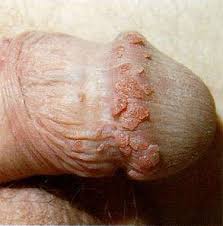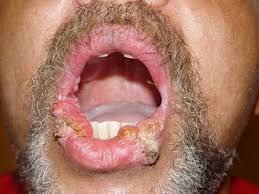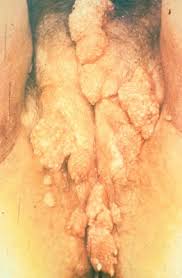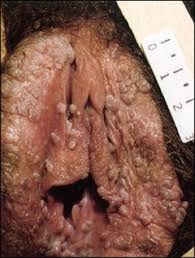Genital warts, also known as condylomata acuminata or venereal warts, are one of the most common types of sexually transmitted diseases (STD). The genital wart viruses (types of Human Papilloma viruses or HPVs) are different from the viruses that cause the warts that people get on their hands and feet.
Genital Warts are the most common sexually transmitted infection diagnosed in clinics in North America and Europe.
- Genital warts are increasingly common and affect as many as one-third of young women in Canada and USA. These warts, spread by sexual contact, are often flat, tiny and difficult to spot and diagnose.
- Genital warts can be spread during vaginal or anal sex, and by sharing sex toys. However, you don’t need to have sexual intercourse to pass it on.
- Genital Warts don’t have to be present to become infected with HPV because it can be caught from touching the infected skin or through sexual fluids.
- Fast becoming a world wide epidemic with 6.2 million new cases each year in the US alone.
Genital warts are very contagious and are spread during oral, vaginal, or anal sex with an infected partner. They are transmitted by skin-to-skin contact during vaginal, anal, or (rarely) oral sex with someone who is infected. Genital warts should not be confused with Fordyce’s spots , which are considered benign.
Genital warts are bumps of various sizes on the skin of the genitals. They result from infection with some types of human papillomavirus, or HPV (a common sexually transmitted virus). Genital warts are caused by a virus which is passed on from direct skin to skin contact during sexual contact or sexual intercourse with an infected partner, usually during vaginal, anal, or oral sex play. They can spread even when no warts are visible.





Symptoms include:
- Genital warts are cauliflower-like lumps, in and around the genital area, and in some cases the anus.
- Genital warts look like small flesh-colored, pink, or red growths in or around the sex organs. The warts may look similar to the small parts of a cauliflower or they may be very tiny and difficult to see.
- Genital warts typically present as flesh-colored, exophytic lesions on the external genitalia, including the penis, vulva, scrotum, perineum, and perianal skin.
- External warts can appear as small bumps, or they may be flat, verrucous, or pedunculated. Genital warts can vary in color, from pink to brown, but generally look like small pink or red growths. They can cluster together and take on a cauliflower-like appearance.
- Genital warts are soft to touch and can be itchy. The warts can be very small and go unnoticed.
- A person with genital warts is carrying a virus. So Genital warts are very easily transmitted.
- Using condoms and dams (a thin latex square held over the vaginal or anal area during oral sex) provides some protection, but they only protect the area of skin they cover.
- For men wart growth is common on the head of the penis, the shaft of the penis, or randomly on the scrotum or around the anus.
- Women most commonly first get them on the tissue at the opening of the vagina that is closest to the anus and on the labia surrounding this tissue.
Genital warts are spread by sexual contact with an infected partner and are very contagious. Approximately two-thirds of all persons who have sexual contact with an infected partner will develop this sexually transmitted disease (STD).
Genital warts in women often cause abnormal Pap test results. Certain types of HPV increase the risk of cervical cancer.
Genital warts are passed on by direct skin-to-skin contact. Condoms reduce the risk, but they only protect the area of skin covered by the condom. Genital warts are warts that are located near or in the genital areas. In a female, that means on or near the vulva (the outside genital area), vagina, cervix, or anus.
Genital warts, also called human papillomavirus (HPV), is a group of 70 or more viruses that infect the skin and cause warts. HPV is a very common virus, and it is likely that you will probably be exposed to one more strains of it during your lifetime. Genital warts that are visible need to be removed and should never be allowed to grow any bigger than they first appear. The doctor that you see will discuss with you the ways in which they remove genital warts. Genital warts differ from the common wart in where they grow in the warm, moist genital areas of the body.

Genital warts can also develop in the mouth or throat of a person who has oral sex with someone infected with HPV causing virus. Genital warts is a leading cause of cervical cancer in women and can cause penile cancer in men. Genital warts may resolve without treatment in immunocompetent patients but may persist and spread in patients with decreased cell-mediated immunity (eg, HIV infection).
Sometimes these bumps can even arise in the mouth or throat after having oral sex with someone who has the disease. Women can take a Pap smear test to check for presence of human papilloma virus infection on the cervix. In a Pap smear, a laboratory worker examines cells scraped from the cervix under a microscope to see if they are cancerous.
Women should have regular cervical screening tests whether or not they have genital warts. Visible genital warts are not linked to cervical cancer and women who have had them do not need cervical screening tests more often than other women. HPV can pass through small tears in the skin of your genitals that happen during sex.
A wart will appear in the same area, usually within 3 months but sometimes not for years. HPV is easiest to pass on when there are visible warts present, but there is an infectious period before they appear and after they resolve. The length of this period is unknown. HPV may be passed even when there are no visible warts.
HPV can probably never be completely removed from the body, since viruses are extremely difficult to eradicate. However, warts can be treated using medications applied to them, or special injections at the base of the warts, or by removal. HPV is very common, so most sexually active men and women are likely to have been exposed to HPV. The virus maybe preventable with a new vaccine which is being tested currently.
30–60% of males whose partners have HPV acquire the virus in their own body. HPV can also cause cervical cancer if they are not treated. You can be infected with genital warts by direct sexual or skin-to-skin contact and a mother also can pass on the virus to her baby at birth.
Diagnosis of genital warts is made by visual inspection and may be confirmed by biopsy, although biopsy is needed only under certain circumstances (e.g., if the diagnosis is uncertain; the lesions do not respond to standard therapy; the disease worsens during therapy; the patient is immunocompromised; or warts are pigmented, indurated, fixed, bleeding, or ulcerated). Genital warts should be consulted with your doctor.
Genital warts can be transmitted from the mother to the child during childbirth. Occasionally, the child will develop the warts on his or her larynx.
Depending on the location of the warts will decide how your doctor will treat them. If they are located on the outer areas of the genitals the most common form of treatment is liquid nitrogen, which freeze the cells of the warts.
Condoms are usually ineffectual in preventing the spread of warts. However they are usually a very effective means of reducing the risk of other sexual infections and therefore should be considered even after the warts have disappeared. Condoms can help protect you from the HPV virus. However, because condoms do not completely cover the skin surrounding the genitals, you can still get the HPV virus if you come into direct contact with genital warts. Condoms may help reduce the risk of HPV infection.


